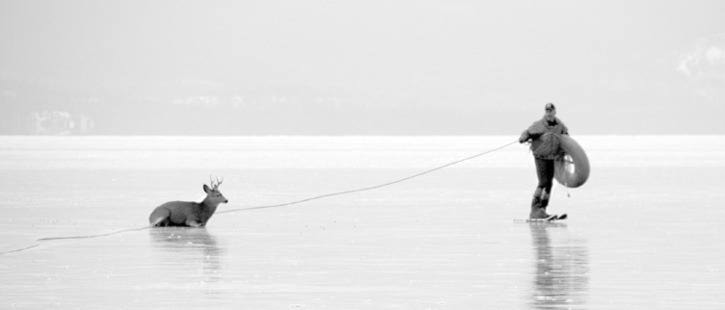Ruth Lloyd
Black Press
In early December, local Conservation Officer Cam Hill was on thin ice, literally.
But Hill was not out playing on thin ice out of any need for danger or excitement, but instead to help a stranded animal, trapped on the glassy ice.
On Dec. 7, Hill, along with four Ministry of Forest, Lands and Natural Resource Operations officers carried out a rescue effort after a concerned resident on Stones Bay Road called for help.
The resident could see there was a deer out on Stuart Lake on the glassy new ice, which was still thin in that area at the time.
Hill said he wasn’t sure how long the deer had been struggling, but the buck had likely been chased out onto the lake by coyotes, wolves or dogs, and when it fell on the ice it couldn’t get up, the ice was so slippery.
In order to rescue the deer, Hill went out onto the ice on snowshoes which he didn’t strap to his feet in case he fell through. The snowshoes helped to spread his weight so he could go out on the thin ice, which varied from only three-quarters of an inch to two inches.
Hill also wore a neoprene wetsuit and a floatation jacket, carried a tube and was tied in by a safety rope, which the other helpers fed out and kept hold of in case the ice gave way.
The deer was then helped to shore and left to recover away from the ice. However, the deer still could not stand up, which may have been due to hip displacement.
The rescued deer did not survive the night, but the operation was still a success in problem-solving and Hill and his team did what they could to help an animal in distress.
“There are no rules or guidelines around conducting an operation like this so every experience helps one to refine what works and what doesn’t and tests one’s ability to be creative to ensure that things go well for the rescuers and the animal being rescued,” said Hill.
He also said there is no set standard practice for this type of operation, and while he has not done one on a lake like this case, he has, however, done similar operations with moose on river ice.
Wolves and coyotes may have been the culprits, chasing the animal out onto the ice, however, dogs may also have been to blame and therefore owners may need to be extra vigilant about keeping their dogs under control due to the snow conditions.
“The current weather conditions have created a snowpack with a crust layer that easily allows dogs to run on top of the snow but deer and other ungulates will falter and fall through, making travel difficult,” said Hill.
He is also now investigating a file in which two family dogs chased down and killed a deer on the Nechako River.
Anyone aware of such activity can call the Conservation Officer Service RAPP line at 1-952-RAPP (7277). Callers have the choice of giving their names or remaining anonymous.
